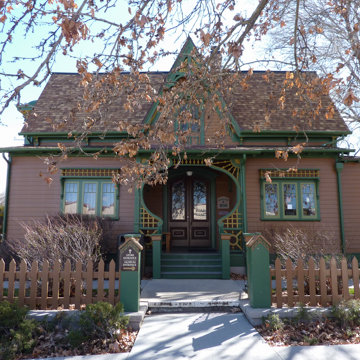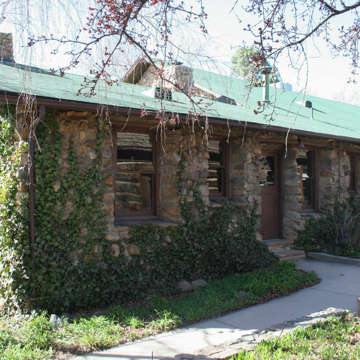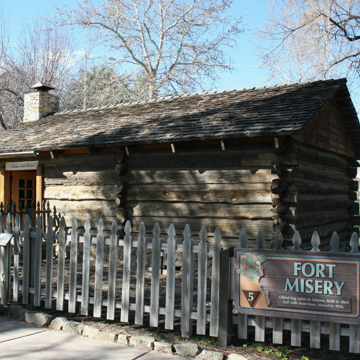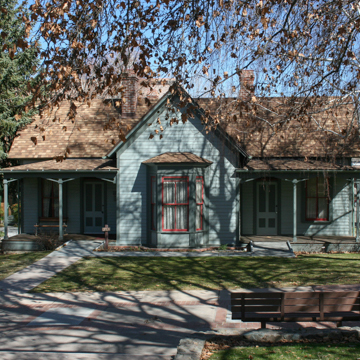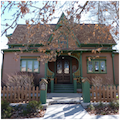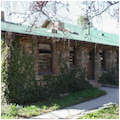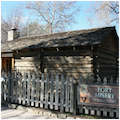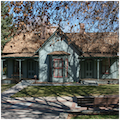You are here
Sharlot Hall Museum
Founded in 1927 as the Old Governor’s Mansion Museum by Sharlot Mabridth Hall (1870–1943), this open-air museum is a collection of nineteenth- and twentieth-century buildings sited on a three-acre parcel two blocks west of Courthouse Plaza in downtown Prescott. Prescott served as the Arizona Territory’s capital from 1863 until 1867, and the museum’s centerpiece is the Territorial Governor’s Mansion, the only building original to the site, constructed in 1864 by laborers under the direction of Samuel Blair. The log building served as the residence and office of the first territorial governor, John Noble Goodwin. Hall spent her life preserving this building as well as relics of Arizona's frontier culture, and used the mansion to exhibit her private collection of Native American and pioneer artifacts. The museum was named in her honor in 1943.
Born in Kansas, Hall moved with her parents and brother to the Arizona Territory at the age of 12. A product of frontier life, Sharlot was reared on Orchard Ranch, where her parents raised horses and livestock while mining for gold on Lynx Creek. She was sent to Prescott for her education, where she remained. In 1909, Sharlot was appointed Territorial Historian, the first Arizona Territorial post held by a woman. Hall was also the first woman elected to the Arizona Women’s Hall of Fame in 1981.
After opening the Old Governor’s Mansion Museum to the public in 1928, Hall sought funding from the Civil Works Administration (CWA) to erect a new museum building in 1933–1934. Completed with additional New Deal assistance in 1936, the rustic edifice now named for Hall served as the primary exhibition space with two galleries. Constructed of native rock and ponderosa pine logs, the building’s materials and form mimic those of the of the Old Governor’s Mansion, its near neighbor. Exhibits highlight the history of the Arizona Territory from 1863 through statehood in 1912, as well as the state’s historic industries and cultures. The Works Progress Administration (WPA) funded the construction of the Ranch House, which interprets early territorial homesteads. The rough-hewn, ponderosa pine cabin features one multipurpose room centered on a stone hearth. Hall used the building to display her collection of saddles and branding irons.
In 1934, Hall had a piece of Fort Misery—the oldest log cabin associated with the Arizona Territory—disassembled and rebuilt on the museum grounds. Now the oldest building in the museum collection, it was built originally in 1863–1864 as a trading post by a Santa Fe trader, Manuel Yrissari, on the banks of Granite Creek, two blocks south of the museum. In the intervening years, the building served as Arizona’s first law office, a general store, a Protestant chapel, a boarding house, and the first courthouse in Arizona. It was completely reconstructed in 1996–1997 with funds provided by Arizona State Parks, and is interpreted as the 1890s residence of Judge John Howard.
Following Hall’s death, the museum’s administration began relocating other local historic buildings, often threatened by demolition or decay, to the property. In 1962 the rotary club built a replica of Prescott’s frontier, one-room schoolhouse, originally built by Samuel Rogers and located on Granite Creek until it was destroyed by fire in 1948. An 1885 iron turbine windmill was relocated from a local ranch. The Transportation Building (1937), which served as an automobile repair shop, displays a collection of antique vehicles. The Frémont House (1875), a milled-lumber residence of the fifth territorial governor (1878–1881) and erstwhile presidential candidate (1856), John Charles Frémont, was moved from its original location in downtown Prescott and restored in 1971. Similarly, the Bashford House (1877), owned by merchant William Coles Bashford, was moved to the museum grounds in 1974. This Carpenter Gothic, I-house cottage currently holds the museum’s gift shop.
The ad-hoc collection is organized around a central mall (formerly Capitol Drive, now closed) opening upon West Gurley Street, from which the buildings radiate. Concrete walks link the disparate buildings, while thematic gardens and mature trees soften the densely built landscape. The Lawler Museum Center (1979), lining the southern edge of the property, serves as the Sharlot Hall Museum Library and Archives research center, exhibition space, and storage facility. The Prescott Valley Historical Society also has its offices in the museum. Besides these buildings, the museum also manages Orchard Ranch, Hall’s family residence east of Prescott, which is also open to the public as a historic site.
References
Fink, Robert, “Old Governor’s Mansion,” Yavapai County, Arizona. National Register of Historic Places Registration Form, 1971. National Park Service, U.S. Department of the Interior, Washington, D.C.
Miller, Raymond E. Prescott. Charleston, SC: Arcadia Publishing, 2010.
“Sharlot Hall Museum.” Sharlot Hall Museum. Accessed July 28, 2015. https://sharlot.org/.
Wildfang, Frederic B. Prescott. Charleston, SC: Arcadia Publishing, 2006.
Writing Credits
If SAH Archipedia has been useful to you, please consider supporting it.
SAH Archipedia tells the story of the United States through its buildings, landscapes, and cities. This freely available resource empowers the public with authoritative knowledge that deepens their understanding and appreciation of the built environment. But the Society of Architectural Historians, which created SAH Archipedia with University of Virginia Press, needs your support to maintain the high-caliber research, writing, photography, cartography, editing, design, and programming that make SAH Archipedia a trusted online resource available to all who value the history of place, heritage tourism, and learning.




















